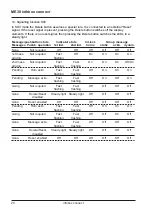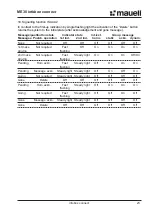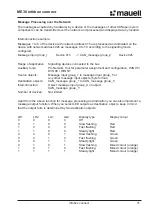
ME30 infobox connect
infobox connect
29
Network Message Functions
The signalling functions supported by all devices always apply to the corresponding device.
The bus capability of the infobox connect device with CANopen interface allows several
devices to be interconnected in a network. This makes it possible to implement new global
functions.
Flashing Pulse Synchronization
If alarms are triggered simultaneously on several devices, the flashing frequencies can be
synchronized in order to get a unique signalling image. One of the devices connected to the
bus must be defined as the master which synchronizes the flashing frequencies of the other
devices.
Interconnection example:
The flashing frequencies of the devices connected to the network are synchronized.
Master_for_flashing pulse synchr. Device 01h -> Slave_for_flash. pulse synchr. Device 02h
Master_for_flashing pulse synchr. Device 01h -> Slave_for_flash. pulse synchr. Device 03h
Range of application:
Signalling devices connected to the bus
Auxiliary tools:
PC-Network Tool for parameter assignment and configuration, WIN 95 /
WIN 98 / WIN NT
Source objects:
Master_for_flashing pulse synchronization
Destination objects:
Slave_for_flashing pulse synchronization
Interconnection:
Object Master_for_flash. pulse synchr. Device 1 on objects Slave_for_
flashing pulse synchronization Devices 2 to n
Number of devices:
Not limited
First-up Value Synchronization
First-up indication means emphasized indication of the first arriving message. This function
synchronizes the first-up indication of all devices connected to the bus. The master (object
‘first-up value master’) receives a signal when a first-up value is pending on one of the slave
devices (object ‘First-up value slave’). The first-up value master can receive the local first-up
values of up to 10 slave devices. If a first-up value is pending on the master itself or on one of
the slaves, the master sends a global signal to all slaves by means of an inhibiting object
(object ‘First-up value inhibiting master’) so that all subsequent messages will not be processed
as first-up values.
Interconnection example:
On the three devices connected to the network the first arriving message on each device is
indicated by a fast flashing light. The device with the address 01h is defined as ‘first-up value
master’.
First-up value_slave_2
Device 02h First-up value_master_2 Device 01h
First-up value_slave_3
Device 03h First-up value_master_3 Device 01h
First-up value inhibiting_master Device 01h First-up value inhibiting_slave Device 02h
First-up value inhibiting_master Device 01h First-up value inhibiting_slave Device 03h












































